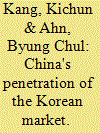| Srl | Item |
| 1 |
ID:
099161


|
|
|
|
|
| Publication |
2010.
|
| Summary/Abstract |
China's penetration of the world market has been impressive. This paper uses highly disaggregated Korean import data (from 1992 to 2008) to examine China's penetration of the Korean market in the context of the composition of value (the extensive and intensive margins) and the product type (homogeneous and differentiated) in trade. The increase in Chinese imports has been attributed to the rapid increase in the import of new products (the extensive margin) and of existing products (the intensive margin). However, the growth rate of new products decelerated in the 2000s. The growth in the intensive margin was due to quantity, not price. Chinese imports to Korea did not improve over the period in terms of quality. Although Chinese products became cheaper, they were more differentiated over time. Welfare gains were realized through the expanded introduction of new products from China. However, much of the gains from Korea's Chinese product import boom were realized in earlier years (1992-2000) because even though imported products became more differentiated, the increase in the extensive margin was lower in more recent years (2001-2008).
|
|
|
|
|
|
|
|
|
|
|
|
|
|
|
|
| 2 |
ID:
161845


|
|
|
|
|
| Summary/Abstract |
This paper examines China's money demand using a Normalized Quadratic function in the search for global flexibility and easing of the degree of freedom. I impose the theoretical regularity conditions in the model that much of the previous literature ignores. I provide the robust estimates of the Morishima elasticities of substitution among currency, demand deposits and time deposits. I find that currency and demand deposits are elastic substitutes in use, while time deposits are inelastic substitutes with the former two. Time deposits are distant from a medium of exchange, and agents treat them as a saving asset, separable from the composite of currency and demand deposits. The results imply that the narrow money M1 is well-defined, while the broad money M2, which assumes perfect substitution of the component assets, is problematic. A monetary aggregate that internalizes the substitution effects should be adopted in China.
|
|
|
|
|
|
|
|
|
|
|
|
|
|
|
|
| 3 |
ID:
119264


|
|
|
|
|
| Publication |
2013.
|
| Summary/Abstract |
This article introduces a supply-side perspective to the study of counterterrorism, where terrorists are viewed as combining terrorist attacks to achieve an aggregate output (e.g. social anxiety). With this novel approach, the elasticity of substitution, associated with the terrorists' production function, becomes a key determinant of the effectiveness of deterrence. If this elasticity is large, then countermeasures have very limited effectiveness when directed at a single mode of attack. If, in contrast, attack modes are complements, focused countermeasures can completely eliminate terrorists' gains. Counterterrorism measures are more effective when terrorist campaigns display little diversity of attacks. The article also identifies when proactive policies are more effective than defensive policies. The supply-side perspective gives a new pessimistic view to benevolence, which reduces the cost of nonterrorist activities.
|
|
|
|
|
|
|
|
|
|
|
|
|
|
|
|